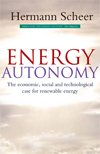 Speech of Dr. Hermann Scheer at the Opening Session of the European Wind Energy Conference, Copenhagen, July 2nd, 2001
Speech of Dr. Hermann Scheer at the Opening Session of the European Wind Energy Conference, Copenhagen, July 2nd, 2001The possible role of Renewable Energies is being underestimated in politics and in the general public - including the mass media. This underestimation is based on various misinformations, intentionally disseminated by two very different groups: by the established nuclear and fossil power companies on the one hand, on the other hand by some traditional nature conservation initiatives, telling nonsense on the subject of wind energy or other Renewables.
In a book about these different kinds of opposition, edited in 1998, I called it a "windy protest". Many people - and this includes politicians and journalists – lacking comprehensive information about this new technology, do repeat the misinformation. A similar situation was experienced when, in the 19th Century, the first railways were built, before rail transport was realized to be the environmentally soundest system for mass transportation.
To generalize the real potential of wind power, we must think in substitutions of conventional power. The IEA forecasts, for 2020, a worldwide electricity demand of 17 trillion kWh generated by nuclear and fossil resources. Should we want to generate 17 trillion kWh by wind power, we ought to install 5.7 million windmills with 1.5 MWp each. If we set a target of meeting one third of the total electricity demand by wind energy, we would need some 2 million windmills of the above capacity. Why not?
This does not burden the landscape. On the contrary we would save the landscape by reducing water consumption for fossil and nuclear steam power stations, by avoiding acid rain and water contamination by oil, by protecting the climate and reducing the number of pylons due to the substitution of large power stations.
I am not speaking merely in theories but as a policy designer in the German Parliament for the two decisive laws which initiated the introduction of meanwhile 7,000 MW wind power within 10 years - the Renewable Energy-Feed-In-Tariff Law of 1991 and its follow-up: the Renewable Energy Act of April 2000. This law resulted in the fact that 35 % of the total new wind power systems installed worldwide per year is installed in my country. These laws came into force in spite of the misinformation and opposition mentioned above, a conflict holding busy the Supreme Constitutional Court in Germany and the Supreme European Court, as large power companies filed suits.
Finally, the European Court backed the position of the red/green majority in the German Parliament by its decision on March 13, 2001: it judged that the common obligation in the European Treaties for the protection of environment could be given priority over market rules which do not distinguish between the different social costs.
On this way we proved wrong all the doubts concerning a legal floor price system. The advantages and disadvantages of a so called quota and tendering system on the one hand, so far understood to be the only system compatible with common market principles, and, on the other hand, the systems of a granted minimum price - including priority access to the grid - were also discussed at European Wind Energy Conferences before. Now it is obvious that the floor price system, including market priority for electricity from Renewable Energy sources, is the only successful system for a fast and widespread introduction of Renewable Energies.
What about the future of wind energy and the environment if we hadn't insisted on keeping and extending our floor price system? What about the state of windpower in Europe without this legal framework in Germany, in Spain, and, till the end of 1999, in Denmark?
The best chance to compare the two different legal frameworks is offered by Denmark: they changed, in 2000, from the floor price system to a quota system. Based on the new framework, no installation was built since. During two decades, Denmark was the key example for wind energy production and introduction. It was the highlight, motivating all the other countries. But since the system was changed, very few installations were built based on the new system. Being a German Parliamentarian and admiring the Danish Wind Energy movement, I don't want to interfere in the Danish decisions. But in my role as President of EUROSOLAR, I have to fight for the successful and more promising examples everywhere. We had to block the plans of some parts of the Commission and of EURELECTRIC - the European Association of power companies - to oblige all member states of the EU to introduce the quota system in their territories. These plans are already supported by the Danish government. We blocked this kind of interference in our legal framework, together with our friends in the European Parliament. Let's have an open discussion on that matter, as this is the salt of democracy.
The Danish wind-energy industry is an indispensable cornerstone for a worldwide introduction and I hope its role will be extended and fostered. But what would have happened for this industry in the past two years without the market in floor-price-system countries? So far, some wind energy supporters are favouring the quota system, others the floor-price-system. But: did anybody analyze all motivations of all supporters of the quota system? Certainly not all supporters of the quota system are against wind energy, but all those voting against wind energy do favour the quota system.
EUROSOLAR was the first European Renewable Energy Association to champion the floor prize system since the end of the 80ies, therefore I may speak about the EUROSOLAR model. EURELECTRIC was the first European Energy Association to favour the quota-system - the EURELECTRIC model.
However: the present experience with market introduction and the decision of the European Court - both are reasoning against the approach of EURELECTRIC. Moreover, a systematic evaluation of its consequences speaks against it: In my opinion, the quota system can never become compatible with market rules, because wind power productivity will always depend on the inevitably differing wind conditions. If there existed a functioning quota system in the near future, some buyers of certificates could have contracts with highly productive wind power suppliers and others not. That means: the latter ones would be forced to pay more than the first ones to achieve the very same public obligation. That would violate the principle of equality within the Renewable Energy market.
Furthermore, those supporting the quota system hope that big power suppliers will take over the initiative towards a broad expansion of windmills, a hope which will remain plain paper - at least if we consider the strategies of the big power companies in Europe.
They focus their main attention on joining companies and on concentration - in order to become "pan-European multi-utility suppliers". Several commissioners do support these efforts, as they consider this trend to be "logical and desirable" - including the focus on large conventional power stations, also including a renaissance of nuclear power generation, which is not only on Bush's agenda but is also being discussed in the re-elected British Government.
Future wind power stations might be 1000 MW-off-shore plants and thus be attractive to big power suppliers. This idea could turn out a failure! The largest market for windmills is, and will be, the on-shore sites. And most of the big conventional power suppliers will hesitate, as long as
- they have conventional overcapacities,
- they have the possibilities for long-distance transmission,
- they are playing the role of being not only suppliers of electricity, but more and more suppliers of oil, gas, and coal.
This will result in the fact that they will tend to give priority to fossil and/or nuclear fuels as long as possible.
Wind power will never be introduced by its own force. There is an increased public awareness and desire for Renewable Energies, but the oppositions still exist. So far, many people find kind words for Renewable Energies, but they don't act. The ambitious White Paper of 1997 is not really implemented yet. The new Research Framework Programme of the Commission does no longer refer to wind energy.
Up to now, the driving forces for wind energy are committed people: engineers, producers, individuals, co-operative independent power suppliers, and non-commercial associations for Renewable Energies, environment protection, and development aid. They try to convince the public and the governments in spite of - and by counteracting – the misinformation.
There is an old Chinese saying: When the wind of change starts blowing there are those who build walls and there are others who build windmills. It is our responsibility to dismantle the walls and disseminate Renewable Energies, with Wind Energy as a main driving force.



